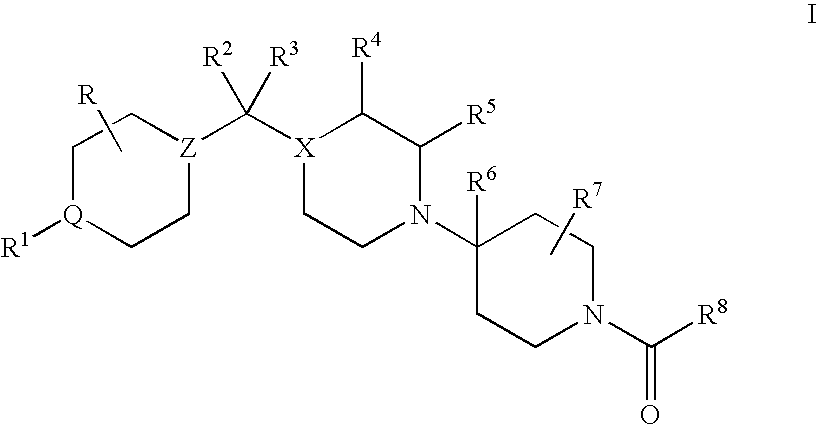CCR5 antagonists useful for treating aids
a technology of ccr5 and antagonists, applied in the field of ccr5 antagonists useful for treating aids, can solve problems such as multi-drug resistan
- Summary
- Abstract
- Description
- Claims
- Application Information
AI Technical Summary
Benefits of technology
Problems solved by technology
Method used
Image
Examples
example 1
[0110]
Step 1:
[0111]The alcohol 1 (2.0 g, 17 mmol), 4-methoxy benzaldehyde (2.5 ml, 21 mmol), and Na(AcO)3BH (4.4 g, 21 mmol) were taken up in CH2Cl2 (50 ml) and stirred at 25° C. for 22 h. The solution was diluted with CH2Cl2 and washed with aqueous 1N NaOH. The aqueous layer was extracted with CH2Cl2. The combined organic layers were dried (Na2SO4), filtered and concentrated. The residue was partitioned between Et2O and 1 M HCl. The acidic, aqueous layer was extracted with Et2O. The aqueous layer was cooled to 0° C. Solid NaOH pellets were added until the pH=11-12. The basic, aqueous layer was extracted with CH2Cl2. The CH2Cl2 layers were dried (Na2SO4), filtered, and concentrated to obtain the benzyl protected piperdino-alcohol (2.92 g, 73%).
[0112]DMSO (1.3 ml, 19 mmol) was taken up in CH2Cl2 (80 ml), and the resulting solution was cooled to −40° C. (CO2 / CH3CN). Oxalyl chloride (1.6 ml, 19 mmol) was added slowly to the solution at 40° C. The solution was allowed to stir at 40° C. ...
example 2
[0125]
[0126]The aldehyde 2 (0.93 g, 4.0 mmol), piperidino-piperazine 3 (1.0 g, 3.4 mmol), and Na(AcO)3BH (860 mg, 4.0 mmol) were taken up in CH2Cl2. (10 ml) and stirred at 25° C. for 18 h. The solution was diluted with CH2Cl2 and washed with 1N NaOH. The aqueous layer was extracted with CH2Cl2. The combined organic layers were dried (Na2SO4), filtered, and concentrated. Purifification via flash chromatography (acetone / CH2Cl2 gradient 2 / 5-3 / 5, SiO2) gave 1.24 g (71%) of 7 as a colorless oil.
[0127]Compound 7 was treated according to the procedures in Steps 4 and 5 of Example 1 to obtain the title compound.
[0128]HRMS (MH+) found: 507.3122.
[0129]Using a similar procedure and the appropriate reagents, compounds of the structure
[0130]
were prepared, wherein R1 and R6 areas defined in the following table:HRMSEx.R1R6(MH+) found2AHCH3429.33402B4-CH3OC6H4CH2CH3548.38382CCF3SO2CH3561.28402DC6H5C(O)CH3533.36112E4-CH3C6H4SO2CH3583.3442
example 3
[0131]
[0132]The alcohol 1 (2.0 g, 17.4 mmol), N-Boc-4-piperidone 11 (3.5 g, 17.4 mmol) and Ti(OiPr)4 (5.7 ml, 19 mmol) were taken up in CH2Cl2 (60 ml) and stirred at 25° C. for 64 h. Diethyl aluminum cyanide (42 ml of a 1.0 M solution in toluene, 42 mmol) was added to the reaction mixture at 25° C. The solution was stirred at 25° C. for an additional 24 h. The solution was poured in a flask containing EtOAc and sat. aqueous NaHCO3 at 0° C. The mixture was filtered through a plug of Celite. The layers were separated, and the aqueous layer was extracted with EtOAc. The combined organic layers were washed with brine and dried (Na2SO4). Filtration and concentration gave the crude cyanide (4.87 g, 87%) as a yellow oil.
[0133]The cyanide (4.87 g, 15 mmol) was taken up in THF (75 ml). CH3MgBr (25 ml of a 3.0 M solution in Et2O) was added to the reaction mixture at 0° C. The solution was allowed to warm to 25° C. and was stirred at that temperature for 18 h. The solution was partitioned betw...
PUM
| Property | Measurement | Unit |
|---|---|---|
| temperature | aaaaa | aaaaa |
| temperature | aaaaa | aaaaa |
| temperature | aaaaa | aaaaa |
Abstract
Description
Claims
Application Information
 Login to View More
Login to View More - R&D
- Intellectual Property
- Life Sciences
- Materials
- Tech Scout
- Unparalleled Data Quality
- Higher Quality Content
- 60% Fewer Hallucinations
Browse by: Latest US Patents, China's latest patents, Technical Efficacy Thesaurus, Application Domain, Technology Topic, Popular Technical Reports.
© 2025 PatSnap. All rights reserved.Legal|Privacy policy|Modern Slavery Act Transparency Statement|Sitemap|About US| Contact US: help@patsnap.com



